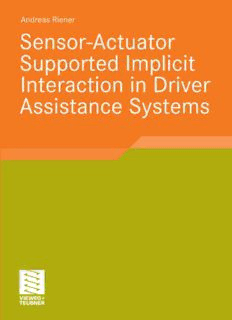
Sensor-Actuator Supported Implicit Interaction in Driver Assistance Systems PDF
Preview Sensor-Actuator Supported Implicit Interaction in Driver Assistance Systems
Andreas Riener Sensor-Actuator Supported Implicit Interaction in Driver Assistance Systems VIEWEG+TEUBNER RESEARCH Andreas Riener Sensor-Actuator Supported Implicit Interaction in Driver Assistance Systems With forewords by Univ.-Prof. Dr. Alois Ferscha and Prof. Dr. Albrecht Schmidt VIEWEG+TEUBNER RESEARCH Bibliographic information published by the Deutsche Nationalbibliothek The Deutsche Nationalbibliothek lists this publication in the Deutsche Nationalbibliografie; detailed bibliographic data are available in the Internet at http://dnb.d-nb.de. Dissertation Universität Linz, 2009 Gedruckt mit Unterstützung des Bundesministeriums für Wissenschaft und Forschung in Wien. 1st Edition 2010 All rights reserved © Vieweg+Teubner | GWV Fachverlage GmbH, Wiesbaden 2010 Editorial Office: Ute Wrasmann | Anita Wilke Vieweg+Teubner is part of the specialist publishing group Springer Science+Business Media. www.viewegteubner.de No part of this publication may be reproduced, stored in a retrieval system or transmitted, in any form or by any means, electronic, mechanical, pho- toc opying, recording, or otherwise, without the prior written permission of the copyright holder. Registered and/orindustrial names,trade names,trade descriptions etc.cited in this publica- tionare part of the law for trade-mark protection and may not be used free in any form or by any means even if this is not specifically marked. Cover design: KünkelLopka Medienentwicklung, Heidelberg Printing company: STRAUSS GMBH, Mörlenbach Printed on acid-free paper Printed in Germany ISBN 978-3-8348-0963-6 Foreword Technologicaladvances,miniaturizationofembeddedcomputingtechnologyandwirelesscom- municationtogetherwiththeevolutionofglobalnetworksliketheInternethavebroughtthe vision of pervasive and ubiquitous computing to life: technology seamlessly woven into the “fabricofeverydaylife”. Alongwiththisdevelopmentgoestheneedandchallengeofinter- facessupportinganintuitive,unobtrusiveanddistractionfreeinteractionwithsuchtechnology- richenvironments.Consideringthehugeamount,andevergrowingnumberofavastmanifold ofheterogeneous,small,embeddedormobiledevicesshapingthe“pervasivecomputingland- scape”, makes traditional, explicit and attention based styles of interaction appear hopeless. Tomakecomputingpartofeverydaylife, theinterfacingmustgobeyondtraditionalexplicit interaction: pervasive computing system designs will have to – and are already successfully attemptingto–reverttheprincipleoftheuserbeinginanactiveandattentiverole,toonewhere technologyisattentiveandactive.Interactionisbecomingimplicit. Implicitinteractionisbasedontwomainconcepts: perceptionandinterpretation. Percep- tion concerns gathering information about the environment and situations, usually involving (technological)sensors. Interpretationisthemechanismtounderstandthesenseddata. Con- ceptually, perception and interpretation when combined are described as situational context. Asystemawareofitssituationalcontextdoesnothavetobeexplicitlyforcedtoact(bythe user),butbycollectingandinterpretinginformationaboutitsenvironmentcanautonomously triggeractions. Inputisnotnecessarilyexplicitlystatedorintentionallygiven,butthesystem understandstheinformationitcollectsasinput. Theactive, drivingroleintheinteractionis thusmovedfromtheusertothesystem. Consequently,theuserdoesnothavetobeattentive andresponsivetoaplethoraofdevices,butthedevices–assingleentitiesorasensemblesof cooperativeentities–developa“sense”fortheuser,andactaccordingly. AndreasRienerhasearlyidentifieddriver-vehicleinterfacesasoneoftheseemerging“perva- sivecomputinglandscapes”,i.e. complexconfigurationsoftechnologicalsystemcomponents andservices,and“implicitinteraction”thereinasamajorresearchchallenge. Seenfromthe technologicalperspective,advanceddriverassistancesystemsandin-vehicleinformationand entertainmentsystemshaveexperiencedanexplosivegrowthoverthepasttwodecades, and arenowamongthemostresearchedpervasivecomputingsystemsattheconfluenceofindus- trialandacademicresearchendeavors.Thesearchforknowledgefromacomputerscienceand engineeringviewpointisoftenmotivatedbypracticalaswellasindustrialapplicationsandis oftennotfarremovedfromthegoalofpracticalutility.Thespectrumofdisciplinesincreasingly engagingtoanswertheresearchquestionsraisedoutofthisdomainis,however,overwhelming. Psychologicalandpsycho-physiologicalresearchattemptstounderstandthemultifacetedrela- tionsamongthedifferentmodalitiesofstimulusandperceptionorsensation,theindividualrole VI Foreword andsynesthesiaofsenseorgansforperception,themodelingandrecognitionofvitalstatefrom biosignals,memorizingandrecallingsensation,etc.Neurophysiologicalresearchandcognitive scienceaddressestheissuesofattention,memory,learning,perceptionandactionfromamore behavioralaspect.Evensociologicalresearchengagestoexplainanddeliverempiricalevidence forphenomenaobservedwhensocio-technicalsystemslikedriver-vehiclesystemsareusedat largescale.Thequestionsposedandthemethodsusedtoconductresearchwithinthisfieldare asvariedasarethedisciplinesdevotedtoit. ThequestionsposedbyAndreasRienerinthisbookconcernin-vehicleinteractiondesign issues,particularlythepotentialutilityofhapticsandvibrotactilestimulation,aswellasdriver anddrivervitalstaterecognitionfromembeddedsensors,bothfromatechnologicalperspective. Usabilityengineeringresearchmethodsareadopted,andempiricalevidenceisdeliveredfrom casesinvolvingrealusersandrealsystems. Sincethebeginningofresearchinautomotiveuserinterfaces, avarietyofscientificdisci- plines and research effortshave addressed the role of the sense of touchfor perception, and passiveinteractionforarticulation. Theparticularresults,theindividualfindings,therelated bodyofliterature,however,havenotyetledtoacomprehensivetheoryof“hapticperception”, or“implicitinteraction”. Thiswork,forthefirsttime,systematicallysortsoutpreviouscontri- butionstoanswerinterfacedesignissueswherehapticperceptionmeltswithimplicitinteraction inatechnology-richsettingofeverydayuse: thecar. Itclarifiesmanyfacetsofwheretheuse ofhapticsisbeneficialindriver-vehicleinteractions,andexemplifieshowcurrentautomotive interfacescanbeimproved.Manifoldarethefindingsthatconcerntheinteractionloopfromthe drivertothevehicleandback,someofthemelucidatingbasicprinciplesofhapticsininterface design-notrestrictedtotheautomotivedomain. Manifoldarealsothefindingsthatpostulate humanattentionandsituationawarenessastheprimaryautomotiveinterfacedesignconcerns. Fortunately, however, alsomanyquestionsremainunanswered. Amongthemostfundamen- talonesthatthisbookraises, isthescientificclarificationoftheprocessfromhumanhaptic per-ceptiontocognition,andmodelsformemorizing,remembering,learningandforgetting- withinandoutsidethedomainofautomotiveinterfaceapplications. AloisFerscha Foreword IhadthepleasuretobetheexternalexaminerforthePhDdissertationbyAndreasRiener. At theMenschandComputerconferenceinLübeck,Germany,Andreasgavemeafirstdraft. At first,Iwasabitshockedbythesizeofthedocument(ifIrememberright–closeto300pages). WhenIstartedtoreadthethesisIwasprettyimpressedbytheamountofrelatedworkAndreas cited that I did not know before. For me this is always a good indicator that students have diveddeepintotheirtopic. Theexperimentalpartoftheworkisexcitinginasimilarway. I havecomeacrossanumberofnewapproachesforexperiments;myfavoriteoneiswhereAlois Ferscha’spassionforcarracingbecomesclearlyevident.Afurtherreasonwhyhisdissertation isexcitingisthatAndreasdidtheresearchinthecontextofchallengingreal-worldprojectsand applications. As the basic technologies (processing, wireless networks, sensors, and actuators) become morewidelyavailabletheytransformvehiclesandinparticularcarsintointeractivecomputer systems. Carsarecurrentlybecomingaplatformandinteractioninthisdomainisverychal- lengingduetotheprimarytaskofdriving.Embeddingcomputing,communication,andservices intovehiclesistechnicallypossible;however,makingapplicationsusableandsafetousewhile drivingisstillanopenissue. Thisbookdescribesresearchatthecrossroadsofpervasivecom- putingandhumancomputerinteraction(HCI),addressingthequestionhowtoexploitexplicit aswellasimplicitinteractionforautomotiveuserinterfaces.Thecentralpartoftheresearchis theassessmentofusingthehumansenseoftouchandinparticulartactilemodalitiesasanaddi- tionalinteractionchannelfordrivers.Howtoefficientlysensetheuser’sstateandintentionsand howtoeffectivelycommunicateinformationtotheuserwithoutincreasingthecognitiveload isahardscientificchallenge. Withhisprototypes, experiments, andempiricaldataAndreas Rienermakesimportantcontributionstothisresearchfield. Withhisworkhemovesforward andshowsasystematicapproachforunderstandingvibro-tactileinteractioninthecar. There- searchquestionsfacedinthisnewdomainarenotasclearasinestablishedfieldsandfindingan appropriateandacceptedresearchmethodologyispartofthework.Especiallywithanincrease incomplexityoffunctionalityprovidedinthecarcreatinguserinterfacesthatarestilleasyand savetouseisverydifficult.Theworkpresentedinthisbookispracticallyapplicable,relevant, andimportant. Themaincontributionsofthebookareintwoareas: (i)theassessmentanduseofsitting postureofthedriverand(ii)theinvestigationofvibro-tactilecommunicationandinteraction asanadditionalchannelinautomotiveHCI.Overalltheresearchshows, basedonempirical validation, that introducing these new modalities can lessen workload and improve reaction time. The research reported is anchored in a large number of prototypes and systems that AndreasRienerhasdevelopedduringhisresearch. VIII Foreword Thebodyofworkwhichisthebasisofthisbookisremarkable. Theworkexemplarilyex- plainsabroadsetofmethodsandtoolsandtheresultsarerelevantfordesigningnovelcaruser interfaces. Despitemyinitialshockonthenumberofpagesthisworkisworthwhileandvery interestingtoread. Prof.Dr.AlbrechtSchmidt Preface Advancesinmicroelectronicsandembeddedsystemstechnologyhaveacceleratedtheevolution ofDriverAssistanceSystemstowardsmoredrivingsafety,comfort,entertainment,andwayfind- ing.Thetechnologicalandqualitativeprogress,however,resultsinasteadilyrisinginteraction complexity,informationoverload,andintricateinterfacedesigns.Assessinginteractiondesigns forin-carassistanceservicesisanemergingandvibrantfieldofresearch. Inthiswork,implicitinteractioninDriver-VehicleInterfacesisintroducedforthepurpose ofrelievingthedriverofcognitiveoverloadsituations. Today’smostfrequentlyusedsensory modalitiesvision(seeing)andhearingareveryoftenhighlychargedduetoalargernumberand complexityof(i)AdvancedDriverAssistanceSystems(ADAS)and/orIn-VehicleInformation Systems(IVIS),(ii)infotainmentdevices,(iii)communicationappliances,andothers. Thesesystemshaveoriginallybeendevelopedforprovidingsupporttothevehicledriver,but unfortunatelytheiroperationandmonitoringincreasinglyhavethedisadvantageofresultingin ahighcognitiveloadforthedrivingpersonandconsequentlyleadtooperationerrors,caused by(i)overlookinginformationor(ii)missingimportantmessages. Anotherproblemcategory aremodality-baseddistractionfactors,suchasglaringorreflectinglight,fog,snowfall,dayand nightvision,andchanginglightconditionsforthevisualchannel,ormotorandtrafficnoise, carstereo,passengercommunication,andcellphonecallsfortheauditorynotificationchannel. Apart from these communication restrictions, possible solutions for the above-mentioned problemshavebeeninvestigatedandthreesuitableoptionshavebeenidentified: (i)theintro- ductionofoneormoreadditionalfeedbackchannels(afeedbackchannelinthiscontextisa dedicatedwayforthedrivertointeractwiththevehicle),(ii)theoptimizationofexistingfeed- backmodalities(e.g.,considerageorsex-relateddifferencesforthevisual,auditory,andother interactionchannels),and(iii)theapplicationofmultimodalinterfaces(thisisasimultaneous activationorstimulationoftwoormorefeedbackchannelsforthepurposeofnotifyingabout onlyoneinformationalitem)incontrasttotheprimarilyappliedunimodalones. Theintroductionandutilizationofmultimodalityisstraightforwardand,therefore,hasbeen excludedfromthiswork;theremainingtwooptionshavebeenextensivelyanalyzedwithboth simulatedandon-the-roadexperiments. Thisresearchworkisstructuredasfollows: TheintroductoryPartIdefinescommonlyused terms,describestraditionalconceptsofinformationprocessingbetweenadriverandthevehicle, indicatesproblemsoccurringinmoderncars,andconcludeswithadefinitionofhypothesesand researchquestions. PartII,whichisdedicatedtoaninvestigationofDriver-2-Vehicle(D2V) interfaces,summarizesrelatedworkonvibro-tactilestimulationwiththeaimtomotivatethe utilizationofthesenseoftouch.PartIIIconsidersinteractionfromadriver’sview,inparticular its notification demands as well as possible causes of distraction, and gives suggestions for
Description: